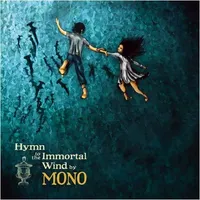10 post-rock albums you should definitely own
While arguments about what post-rock actually is continue to rage, the genre has given us plenty of adventurous and thrilling music

Trying to work out exactly what post-rock is is almost as impossible as getting half a dozen prog fans to agree on what progressive rock is. These days almost everyone has their own take on what a particular genre should be. But in broader terms (and risking the wrath of the purists), post-rock is all about creating non-rock sounds using standard rock instrumentation. So it’s all about things such as the atmospherics and cinematic scope of the music rather than the verse-chorus-verse song structure.
The term was coined by music writer Simon Reynolds while reviewing the 1994 Bark Psychosis album Hex. But, as you will see from our own list, the musical ideas had been around way before then. Post-rock may have evolved out of the indie and shoegaze scenes of the late 80s and early 90s, but it owes far more to sounds from a decade earlier, especially Krautrock, prog rock, space rock, ambient and even jazz, and these days the influence of post-rock can be found in the likes of math rock, drone music and even post-metal.
The dronal qualities of the Velvet Underground are an early pointer to the development of post-rock and later elements of David Bowie, especially his excursions into Kraut with “Heroes” and Low, and later still John Lydon’s appropriation of the genre with Public Image Ltd. The eclectic approach of John Peel’s BBC radio show, giving airtime to bands such as Sonic Youth, My Bloody Valentine, Spacemen 3 and more would have also played a part in the amalgamation of styles in post-rock for a band such as Mogwai.
Stylistically, progressive rock then might appear to be at odds with Peel’s post-punk ethos, even if he’d been a fan of some of it in his earlier days. Yet prog, as much as post-punk, remains very much at the heart of where post-rock has developed. In his book Storm Static Sleep: A Pathway Through Post-Rock music writer Jack Chuter discusses the genre’s impact with Simon Reynolds, who told him: “Within the progressive music currents of the late 60s onwards you get post-rock-like occurrences”.
This goes some way to explaining the popularity of bands such as Talk Talk, Sigur Rós and Wire with many prog fans today.
But post-rock is about more than just prog. It might be music that continues to take the listener on a journey, but very often it does so with its use of shifting dynamics and atmosphere.

Talk Talk - Spirit Of Eden (Parlophone, 1988)
“A fine example of the overlap between prog and punk aesthetics that was such a powerful combination for post-rock,” Jeanette Leech writes in her book Fearless: The Making Of Post-Rock, highlighting the importance of Talk Talk, despite being ahead of the curve. By the time post-rock truly evolved, Talk Talk were done.
Starting as a synth-pop band, by the time of 1986 third album The Colour Of Spring they were experimenting more with textures than with straight-ahead songs. With the spacious, almost jazz-like Spirit Of Eden almost three years later, they struck artistic gold. It’s the yardstick by which all post-rock would be measured.
Sigur Rós - Ágætis Byrjun (Fat Cat, 1999)
The Icelandic post-rockers’ breakthrough second album Ágætis Byrjun saw them shift away slightly from the more ambient textures of debut album Von, introducing more swirling string arrangements and orchestration. As if to prove how clever they were, the strings on Starálfur are all palindromic, while on Olsen Olsen frontman Jonsi sings in the made-up language Vonlenska.
Ágætis Byrjun also included the epic Svefn-g-englar, their first UK single release, and its use in so many films and television shows, from Vanilla Sky to Queer As Folk, means you’ve almost certainly heard Sigur Rós, even if you didn’t know it.
Mogwai - Mogwai Young Team (Chemikal Underground, 1997)
As with many bands on this list, it’s no easy task picking their best album; so many post-rock bands don’t indulge in the mediocre. A case in point Scotland’s Mogwai, who last year scored their very first UK No.1 album with As The Love Continues.
But we’ve opted for the band’s 1997 debut, which announced their arrival in some style. Mogwai’s earlier music packs a weightier punch than today’s stylish sounds. But their deft loud-quiet-loud dynamic is writ large over the likes of Like Herod, while the epic Mogwai Fear Satan showed an early mastery of long-form music.
Explosions In The Sky - The Earth Is Not A Cold Dead Place (Temporary Residence, 2003)
Comprising five lengthy instrumental tracks, all based on reactions to crises, such as Six Days At The Bottom Of The Ocean reflecting the 2000 Kursk submarine disaster, The Earth Is Not A Cold Dead Place is rightly hailed as Explosions In The Sky’s finest hour.
The band’s three guitarists each weave their own path yet intertwine with each other quite beautifully, while the sparing use of bass further colours the lush Explosions sound. It’s all akin to having your mind quietly blown while floating on a cloud.
Slint - Spiderland (Touch & Go, 1991)
“Everybody compared us to King Crimson and Pink Floyd,” Slint bassist Todd Brashear told Prog magazine back in 2014, when Spiderland, the band’s second album, was reissued.
Originally released in 1991, Spiderland is as good an early example as any of the quiet/loud dynamic beloved of most post-rock bands. In a twisting maelstrom of time signatures, angular rhythms and the kind of space afforded music by latter-day Talk Talk, the influence of Sonic Youth is as evident as the proggier bands mentioned earlier. Little wonder one reviewer called it “mid-70s King Crimson gone emo”!
Mono - Hymn To The Immortal Wind (Temporary Residence Limited, 2009)
Like many bands in this list, Japan’s Mono tend to see themselves as transcending genres. And you will certainly hear more classical music influences in their later sound than in other post-rock bands.
Hymn To The Immortal Wind was the band’s fifth album, recorded after they took a year off from touring to concentrate on writing. The break worked wonders. Hymn takes the band on a far more orchestral route, and is probably one of the most melodic releases producer and renowned noisenik Steve Albini has ever been involved with.
Godspeed You! Black Emperor - Lift Your Skinny Fists Like Antennas To Heaven (Constellation, 2000)
With an album comprised of four tracks, all around the 20-minute mark, it’s easy to see why so many see a link between prog and post-rock. Yet while these Canadian post-rockers offer as challenging a listen as Yes’s Tales From Topographic Oceans, its mix of sweeping orchestral sounds and chiming guitars, field recordings, disembodied voices and abruptly crushing crescendos puts it in a different musical area altogether.
Sometimes discordant, always disquieting, Godspeed You!’s second album is the one that really put them on the post-rock map.
While Talk Talk and Bark Psychosis are very much the forerunners of post-rock, Wire are the genre’s grandfathers. They formed in 1976 and were seen as very much part of the art school movement that evolved out of punk, but their seminal early run of three albums, the third being the wonderfully diverse 154, act very much as pointers to where post-rock would evolve (even if purists might turn their noses up at the thought).
On 154 Wire expanded on the sound of Pink Flag and Chairs Missing, and although their art punk pretensions are still evident the wonderful The 15th and A Touching Display signpost where post-rock would begin.
65daysofstatic - The Fall Of Math (Monotreme, 2004)
Although much post-rock is built on cinematic soundscapes, Sheffield’s 65daysofstatic represent the more experimental side of the genre. Frequently eschewing the lengthy atmospherics of many of their peers, their debut album set out their stall with songs that mixed more standard post-rock tropes of chiming guitars and a quiet/ loud dynamic with skittering electronic beats that also makes the outstanding The Fall Of Math at times an unsettling listen.
As with other UK post-rock bands of the time such as Maybeshewill and God Is An Astronaut, 65days brought a gritty prog-metal edge to the genre.
Bark Psychosis - Hex (Circa, 1994)
You can’t really have a guide to post-rock and not include the band that inspired the scene’s actual name, but it’s somewhat ironic that this revered London quartet started life as a Napalm Death covers band, whose very first gig was support to Extreme Noise Terror at London pub The Sir George Robey.
By the time they recorded their debut album, in the crypt of a church in East London, they were a drastically different beast musically. Owing a debt to Talk Talk’s spacious beauty, the album mixes indie-leaning rock with lush electronica to startling effect. Time has diminished its impact, but in 1994 this would have sounded largely like nothing else.
Sign up below to get the latest from Classic Rock, plus exclusive special offers, direct to your inbox!
Writer and broadcaster Jerry Ewing is the Editor of Prog Magazine which he founded for Future Publishing in 2009. He grew up in Sydney and began his writing career in London for Metal Forces magazine in 1989. He has since written for Metal Hammer, Maxim, Vox, Stuff and Bizarre magazines, among others. He created and edited Classic Rock Magazine for Dennis Publishing in 1998 and is the author of a variety of books on both music and sport, including Wonderous Stories; A Journey Through The Landscape Of Progressive Rock.











